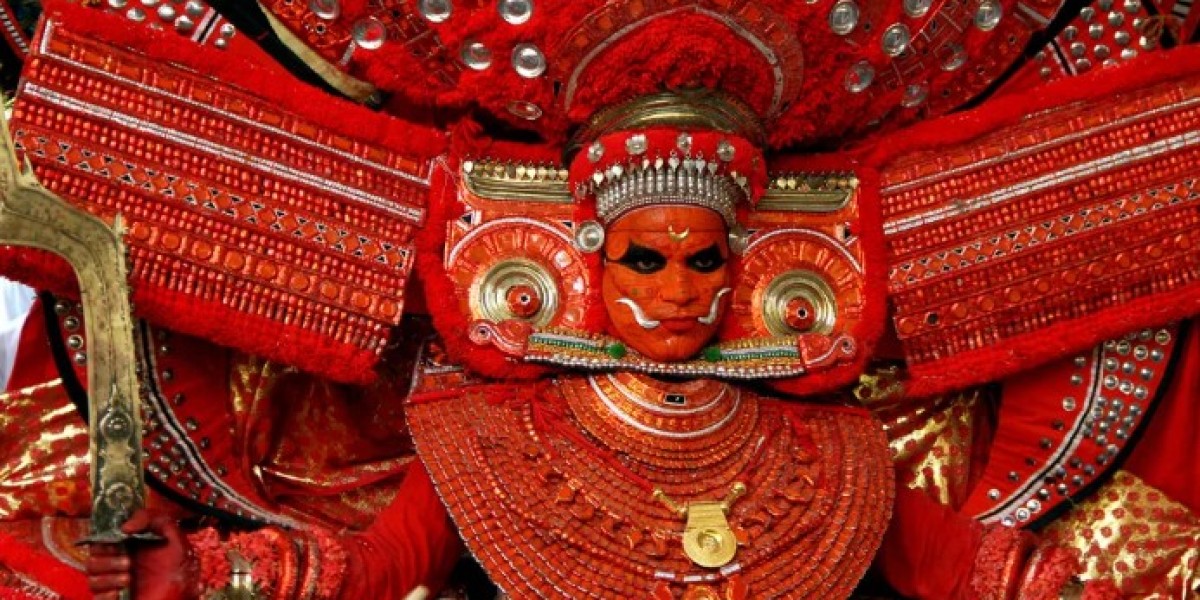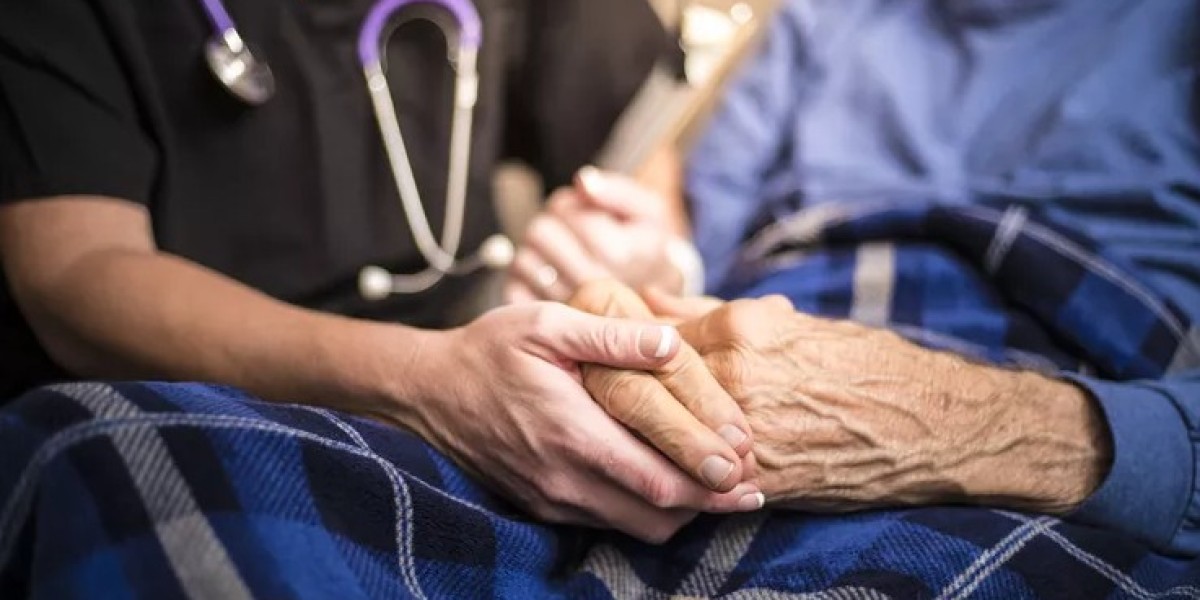The art form of Kerala – ‘God’s Own Country,’ offers a rich cultural tapestry that reflects the region’s history, spirituality, and diversity. Kerala’s art forms encompass a wide spectrum of expressions, ranging from classical dance forms like Kathakali and Mohiniattam to folk arts such as Theyyam and Thiruvathirakali. Each art form is a testament to the state’s artistic prowess, blending mythology, storytelling, and ritualistic practices into mesmerizing performances that captivate both locals and visitors alike. Let’s take a look at some of the most popular art forms of Kerala.
1. Kathakali
Kathakali is a traditional Indian classical dance that is native to Kerala and almost exclusively practiced by them. It is a ‘story play’ genre of art. It is characterized by the traditional male actor-dancers’ elaborately colorful costumes and make-up. Although the fully developed style of Kathakali has its roots in temple and folk arts, it emerged circa 16th century. It also combines moves from South Indian athletic traditions and ancient Indian martial arts. Folktales and religious stories from the Hindu epics and Puranas are the traditional subjects of the Kathakali.
Courtesy – The Statesman
2. Kalaripayattu
Indian martial art Kalaripayattu or Kalari, was developed in Kerala in the 11th century. Kalaripayattu utilizes the Indian ‘guru-shishya’ system. One gains insight and mastery via the teacher’s oral instructions and by studying his stance solely through observation. Kicks, strikes, grappling, predetermined forms, weapons, and healing techniques are all part of Kalaripayattu. The ‘kacha kettal,’ a red and white or red and black loincloth, is the traditional training uniform.
Courtesy – Karma Group
3. Mohiniyattam
Another popular art form in Kerala is the Mohiniyattam or Mohiniattam. The name comes from Mohini, the female avatar of the Hindu deity Vishnu. The ‘Natya Shastra,’ an ancient Hindu Sanskrit text on performance arts, chronicles the way Mohiniyattam must be performed. The ‘lasya’ subgenre is performed in the graceful ‘Kaisiki vritti.’ It is, more precisely, an example of ‘Ekaharya Abhinaya,’ a solo expressive dance performance enhanced by singing and music. Mohiniyattam includes three types of dances — ‘nritta’ (pure dance, solo), ‘nritya’ (expressive dance, solo), and the modern ‘natya’ (play, group dance).
Courtesy – The Creative Post
4. Theyyam
The northern part of Kerala is the hub of the Hindu religious ritual called Theyyam, ‘Tiṟa,’ or ‘Kaḷiyāṭṭaṁ.’ The people look to Theyyam for blessings because they believe that the performance is a conduit to god. The dance form’s roots lie in the veneration of ancestors, particularly among Kerala’s lower castes. This complex dance ritual developed from the ancestor worship ceremony. There are roughly 456 different kinds of Theyyam, each about a different god.
Courtesy – Ranjith Sukumaran via Medium
5. Margamkali
Margamkali is an ancient Indian round dance that is primarily performed by the endogamous Knanaya or Southist Christians; a part of the St. Thomas Christians community. The dance recounts the life and missionary activities of Thomas the Apostle. Usually, a dozen dancers surround a ‘Nilavilakku’ (traditional lamp) dressed in the customary ‘Chattayum Mundum’ as they sing and clap. The lamp represents Christ and the performers, his followers. Traditionally played by men, the participation of boys and women in Margamkali is fairly common now.
Courtesy – Nelson MCBS
6. Koodiyattam
Another art form of Kerala is Koodiyattam, which means “playing/performing together.” It combines elements of Koothu, a performing art from the Sangam era, with elements of ancient Sanskrit theatre. It has been designated as a Masterpiece of the Oral and Intangible Heritage of Humanity by UNESCO. Koodiyattam has traditionally been performed by Nangyaramma, women from the Ambalavasi Nambiar caste, and Chakyars, a subcaste of Kerala Hindus.
Courtesy – Wikimedia Commons
7. Oppana
Oppana is a common social amusement performance art form among Kerala’s Mappila (Kerala Muslim) community. It is a staple of every Mappila wedding. The bride, resplendent in all her glory, her feet and palms encrusted with henna design, sits in the middle of the group of dancers, about fifteen or so including the musicians. Men occasionally also present Oppana to the groom as entertainment.
Courtesy – Wikipedia
8. Thiruvathirakali
Women perform Thiruvathirakali, also known as Kaikottikali or Kummikali, in small groups both during and outside of religious rites. They dance around in a circle and typically sing Shiva Parvati‘s praises in temples on the days of Onam and Thiruvathira. Thiruvathirakali supposedly brings marital bliss to the performers. According to Hindu mythology, it was this dance that revived the God of Love, Kamadeva, after Lord Shiva‘s wrath had reduced him to ashes.
Courtesy – Kerala Tourism
9. Padayani
Padayani (row of warriors) is a ritual theatre art form associated with the Goddess’ temples in Kerala’s Central Travancore regions. It’s an ancient ritual, danced ceremonially while wearing masks in Bhagavati temples. Padayani is presented as a tribute to Bhadrakaali. The length of the festivals varies based on how many villages participate and organize them, ranging from seven to 28 days.
Courtesy – Kerala Special
10. Pulikali
Pulikali is a recreational art form in Kerala. Usually performed on the fourth day of Onam, artists dressed in vivid yellow, red, and black paint, resembling tigers and leopards, shake their stomachs and move to the rhythms of instruments. Pulikali translates to ‘The Tiger Dance,’ hence, the performance’s central theme is tiger hunting. Earlier, participants would have their faces and bodies painted. In modern times, participants now use pre-made masks, fake teeth, tongues, beards, and moustaches.
Courtesy – Hindustan Times
11. Kolkali
Kerala’s Malabar region is home to the folk art form known as Kolkali. The dancers move in a circle, striking little sticks and steps to maintain rhythm. As the dance progresses, the circle expands and contracts. The dance culminates as the accompanying music gradually increases in pitch. Kalarippayattu is the source of many of the Kolkali characters’ body positions, dance moves, and footwork.
Courtesy – The Hindu
12. Mudiyettu
Kerala’s Mudiyettu is a community-based folk dance drama and traditional ritual theatre that enacts the myth of the goddess Kali battling the demon Darika. The dance is performed from February through May, after the harvesting season. Mudiyettu is a custom carried out by Marar and Kuruppu village members. A full Mudiyettu performance needs sixteen performers, including vocalists, percussionists, and Kalamezhuthu artists.
Courtesy – The Traveling Gecko
13. Thullal
The 18th century saw the introduction of Thullal, a satirical and humorous form of social criticism, introduced by the renowned poet Kunchan Nambiar. The Thullal performer is backed by a singer who repeats the verses and is accompanied by an orchestra of cymbals and percussion instruments. The performer’s attire and makeup are similar to those of a Kathakali artist, hence, it is seldom referred to as ‘the poor man’s kathakali.’ Thullal depicts mythological tales and stories through the use of complex language and verse-recited storytelling.
Courtesy – Casual Walker
14. Kalamezhuthu
Kalamezhuthu is a ritual art which uses mixed coloured powders to create exquisite floor paintings that honour and venerate the great gods such as Bhadrakaali, Ayyappan, Serpent, or Vettakkorumakan. After the ritual, these are erased, accompanied by the rhythms of different musical instruments. The ritual uses only natural products, retracted from plants. It includes rice flour (white), turmeric powder (yellow), powdered green leaves (green), and a red mixture of turmeric powder and lime. Kalamezhuthu may take up to two hours to complete the process.
Courtesy – Talent IAS Academy
15. Koothu
Koothu is a socio-religious art form that is either performed separately or as a part of Kutiyattam in the Koothambalam or Koothuthara of temples. It is a solo narrative performance with comedic and mime interspersed. The Chakkiar plays the part of the wise jester, or ‘Vidushaka.’ The Chakkiar parodies the manners and customs with his unique narration of the great epics. His humour varies from lighthearted jokes to subtle innuendos, sharp puns, and sharp insults.
Courtesy – Fstoppers
16. Panchari Melam
A percussion art form called Panchari Melam is often played at Kerala temple festivals. Either the elaborate version of Panchari Melam—performed during the annual temple festivals—or the simplified version—performed to go along with the daily or weekly temple rituals—are performed. The temple deity, carried by the male elephant in the middle of the semicircular procession, is led by a group of captive elephants, numbering anywhere from three to fifteen.
Courtesy – Kerala Drums – Guntur Online
17. Chavittunatakam
Originating in Fort Kochi, Kerala, Chavittunatakam is a vibrant classical Latin Christian art form. It is renowned for the characters’ make-up, their ornate costumes, their expressions, and their well-defined body motions, all of which are synced with the percussion and rhythmic playback music. Chavittunatakam is very similar to European opera, where characters are dressed in glistening medieval attire. It is a type of traditional musical dance drama that represents the Kerala Latin Christians’ martial heritage.
Courtesy -Keralam
18. Sarpam Thullal
The ritual known as Sarpam Thullal (Dance of Snakes) or Nagakalam Pattu is primarily connected to ancestral temples, or ‘tharavadus,’ in the Valluvanadu region of Kerala. The ritual is conducted to appease the snake gods and bring prosperity to the family. The pulluvan and his crew use natural colours to create a floral arrangement on a specially constructed floor. The name of the flower arrangement is Nagakalam. They are composed of coloured powder and ash.
Courtesy – Sarpam Thullal & Kalam Pattu via Facebook
19. Chakyarkoothu
Chakyarkoothu is a performance art form of Kerala. It is an elegant monologue where the performer narrates the tales from the Puranas and Hindu epics. It occasionally doubles as a loose stand-up comedy act that rarely makes personal remarks and frequently offers commentary on current sociopolitical events. The narrator, dressed in a characteristic headpiece and black moustache performs alone. His body is covered in red dots and sandalwood paste. The headgear, reminiscent of a snake’s hood symbolizes the narration by the thousand-headed serpent Anantha.
Courtesy – Sreeraj T via X
20. Vela Kali
During temple festivals, the Nair community of Kerala performs their traditional martial dance, Vela Kali. A battle scene between the Pandavas and Kauravas is portrayed by vibrantly costumed dancers brandishing swords and shields. Vela Kali is exclusively performed by men. The performers don traditional attire, bright red headgear reminiscent of medieval Nair soldiers, and beaded cloth garlands covering their bare chests. The play depicts the triumph of Bheema over the Kauravas during their banishment into the forest, as well as the victory of ‘dharma’ over ‘adharma.’
Courtesy – The Hindu







